A Study of Directionality Effects in Three-Beam Coaxial Titanium Wire-Based Laser Metal Deposition
Abstract
:1. Introduction
2. Materials and Methods
2.1. Experimental Setup
2.2. Experimental Design
2.3. Experimental Procedure
3. Results
4. Discussion
4.1. Experimental Discussion
4.2. Experiment Validation
5. Conclusions
- Over the experimental settings, the three-beam coaxial wire-based laser metal deposition setup was found to have no directional effect on the symmetry of the output bead geometry. The system was directionally independent of the absolute travel direction and the travel direction relative to the laser spot distribution.
- The Skew, Lean, and Mirror measurements were found to effectively capture varying amounts of asymmetry in the profile of a deposited bead. All three measures were based on the bead area distribution and provided viable options to quantify bead profile symmetry.
- The Peak measurement was found to be noisy and inconsistent, likely due to the triangulation of the 3D scanned object. The Peak measure was not area-based and, instead, was based on the position of the maximum relative to the bead width. A very fine STL mesh could be used to alleviate this problem for the Peak measurement, at the slight expense of increased scan file sizes and data processing time.
Author Contributions
Funding
Institutional Review Board Statement
Informed Consent Statement
Data Availability Statement
Conflicts of Interest
Abbreviations
| AM | additive manufacturing |
| DED | directed energy deposition |
| LP | laser power |
| MST | Missouri University of Science and Technology |
| Ti64 | Ti-6Al-4V |
| TC | treatment combination |
| WFS | wire feed speed |
| WIP | workpiece illumination proportion |
References
- Thompson, S.M.; Bian, L.; Shamsaei, N.; Yadollahi, A. An overview of Direct Laser Deposition for additive manufacturing; Part I: Transport phenomena, modeling and diagnostics. Addit. Manuf. 2015, 8, 36–62. [Google Scholar] [CrossRef]
- Abdulrahman, K.O.; Akinlabi, E.T.; Mahamood, R.M. Laser metal deposition technique: Sustainability and environmental impact. Procedia Manuf. 2018, 21, 109–116. [Google Scholar] [CrossRef]
- Ding, D.; Pan, Z.; Cuiuri, D.; Li, H. Wire-feed additive manufacturing of metal components: Technologies, developments and future interests. Int. J. Adv. Manuf. Technol. 2015, 81, 465–481. [Google Scholar] [CrossRef]
- Dass, A.; Moridi, A. State of the Art in Directed Energy Deposition: From Additive Manufacturing to Materials Design. Coatings 2019, 9, 418. [Google Scholar] [CrossRef]
- Ocylok, S.; Leichnitz, M.; Thieme, S.; Nowotny, S. Investigations on Laser Metal Deposition of Stainless Steel 316L with Coaxial Wire Feeding. 2016. Available online: https://blogs.rsc.org/mh/2016/07/21/lane-2016-9th-international-conference-on-photonic-technologies/ (accessed on 26 June 2024).
- Kuznetsov, A.; Jeromen, A.; Levy, G.; Fujishima, M.; Govekar, E. Annular Laser Beam Cladding Process Feasibility Study. Phys. Procedia 2016, 83, 647–656. [Google Scholar] [CrossRef]
- Zapata, A.; Bernauer, C.; Stadter, C.; Kolb, C.G.; Zaeh, M.F. Investigation on the Cause-Effect Relationships between the Process Parameters and the Resulting Geometric Properties for Wire-Based Coaxial Laser Metal Deposition. Metals 2022, 12, 455. [Google Scholar] [CrossRef]
- Wang, Y.K.; Shi, S.H.; Fu, G.Y.; Li, C.S. Research on the Key Process Parameters in Direct Laser Deposition Using Coaxial Inside-Beam Wire Feeding. In Applied Mechanics and Materials; In Proceedings of the Advance in Mechatronics Technology; Trans Tech Publications Ltd.: Zurich, Switzerland, 2011; Volume 43, pp. 401–404. [Google Scholar] [CrossRef]
- Kotar, M.; Govekar, E. The influence of the workpiece illumination proportion in annular laser beam wire deposition process. Procedia CIRP 2018, 74, 228–232. [Google Scholar] [CrossRef]
- Govekar, E.; Jeromen, A.; Kuznetsov, A.; Kotar, M.; Kondo, M. Annular laser beam based direct metal deposition. Procedia CIRP 2018, 74, 222–227. [Google Scholar] [CrossRef]
- Kotar, M.; Fujishima, M.; Levy, G.; Govekar, E. Initial transient phase and stability of annular laser beam direct wire deposition. CIRP Ann. 2019, 68, 233–236. [Google Scholar] [CrossRef]
- Kotar, M.; Fujishima, M.; Levy, G.N.; Govekar, E. Advances in the understanding of the annular laser beam wire cladding process. J. Mater. Process. Technol. 2021, 294, 117105. [Google Scholar] [CrossRef]
- Motta, M.; Demir, A.G.; Previtali, B. High-speed imaging and process characterization of coaxial laser metal wire deposition. Addit. Manuf. 2018, 22, 497–507. [Google Scholar] [CrossRef]
- Ji, S.; Liu, F.; Shi, T.; Fu, G.; Shi, S. Effects of Defocus Distance on Three-Beam Laser Internal Coaxial Wire Cladding. Chin. J. Mech. Eng. 2021, 34, 45. [Google Scholar] [CrossRef]
- Mathenia, R.; Flood, A.; McLain, B.; Sparks, T.; Liou, F. Effects of Laser Defocusing on Bead Geometry in Coaxial Titanium Wire-Based Laser Metal Deposition. Materials 2024, 17, 889. [Google Scholar] [CrossRef] [PubMed]
- Pajukoski, H.; Näkki, J.; Thieme, S.; Tuominen, J.; Nowotny, S.; Vuoristo, P. High performance corrosion resistant coatings by novel coaxial cold- and hot-wire laser cladding methods. J. Laser Appl. 2015, 28, 012011. [Google Scholar] [CrossRef]
- Schwarz, N.; Lammers, M.; Hermsdorf, J.; Kaierle, S.; Ahlers, H.; Lachmayer, R. Direction dependency in coaxial laser double wire Direct Energy Deposition. Procedia CIRP 2022, 111, 196–200. [Google Scholar] [CrossRef]
- Shakhverdova, I.; Nowotny, S.; Thieme, S.; Kubisch, F.; Beyer, E.; Leyens, C. Coaxial Laser Wire Deposition. J. Physics: Conf. Ser. 2018, 1109, 012026. [Google Scholar] [CrossRef]
- Zapata, A.; Bernauer, C.; Hell, M.; Kriz, H.; Zaeh, M.F. Direction-independent temperature monitoring for Laser Metal Deposition with coaxial wire feeding. Procedia CIRP 2022, 111, 302–307. [Google Scholar] [CrossRef]
- Syed, W.U.H.; Li, L. Effects of wire feeding direction and location in multiple layer diode laser direct metal deposition. Appl. Surf. Sci. 2005, 248, 518–524. [Google Scholar] [CrossRef]
- Gabilondo, M.; Cearsolo, X.; Arrue, M.; Castro, F. Influence of Build Orientation, Chamber Temperature and Infill Pattern on Mechanical Properties of 316L Parts Manufactured by Bound Metal Deposition. Materials 2022, 15, 1183. [Google Scholar] [CrossRef]
- Kurose, T.; Abe, Y.; Santos, M.V.A.; Kanaya, Y.; Ishigami, A.; Tanaka, S.; Ito, H. Influence of the Layer Directions on the Properties of 316L Stainless Steel Parts Fabricated through Fused Deposition of Metals. Materials 2020, 13, 2493. [Google Scholar] [CrossRef]
- Pandey, C.; Giri, A.; Mahapatra, M.M. On the prediction of effect of direction of welding on bead geometry and residual deformation of double-sided fillet welds. Int. J. Steel Struct. 2016, 16, 333–345. [Google Scholar] [CrossRef]
- Veiga, F.; Suárez, A.; Aldalur, E.; Bhujangrao, T. Effect of the Metal Transfer Mode on the Symmetry of Bead Geometry in WAAM Aluminum. Symmetry 2021, 13, 1245. [Google Scholar] [CrossRef]
- Veiga, F.; Suarez, A.; Aldalur, E.; Artaza, T. Wire arc additive manufacturing of invar parts: Bead geometry and melt pool monitoring. Measurement 2022, 189, 110452. [Google Scholar] [CrossRef]
- Wire-Based Laser Metal Deposition (LMD-w)—ipt.fraunhofer.de. Available online: https://www.ipt.fraunhofer.de/en/technologies/additive-manufacturing/wire-based-laser-metal-deposition.html (accessed on 21 December 2023).
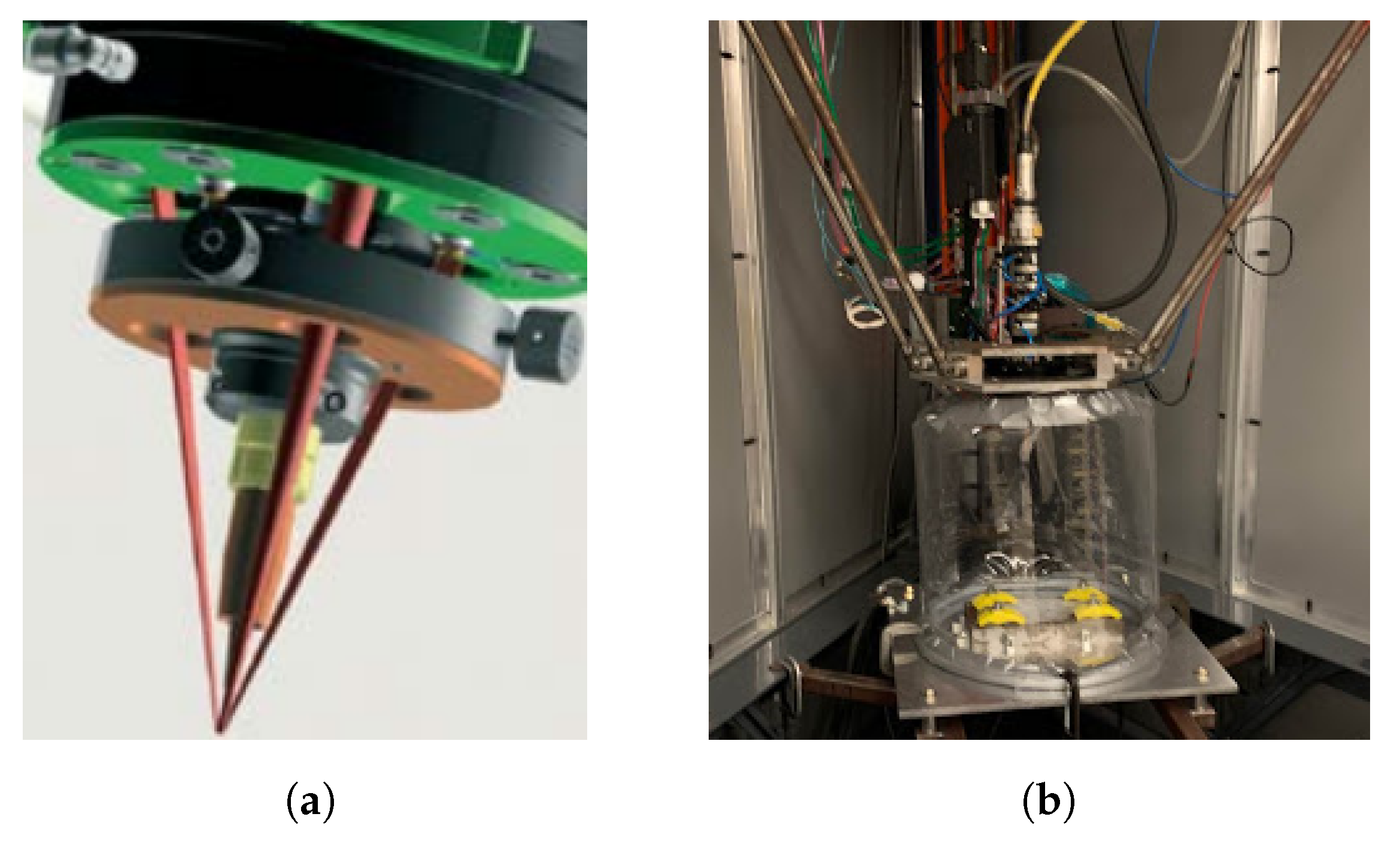
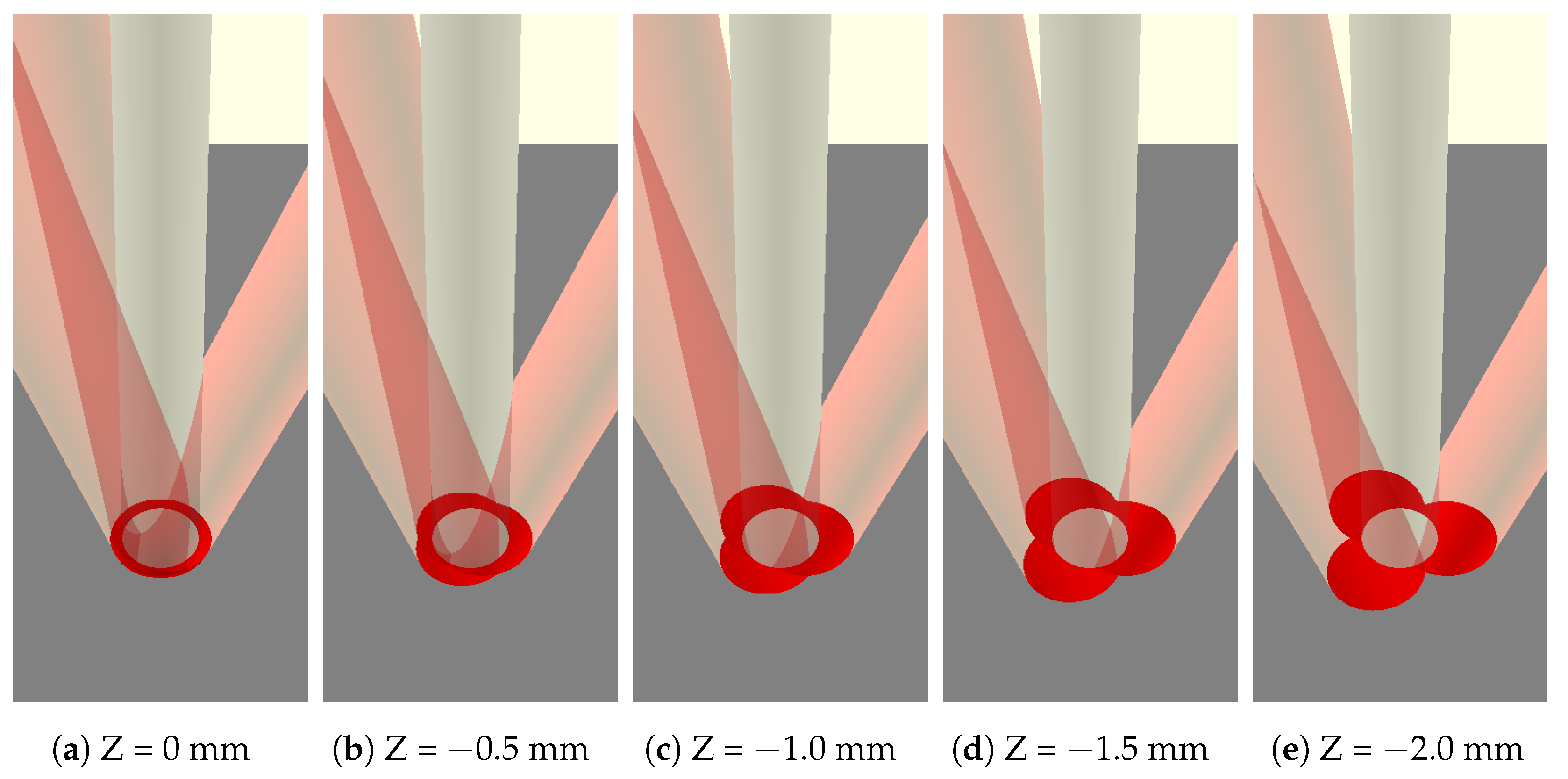
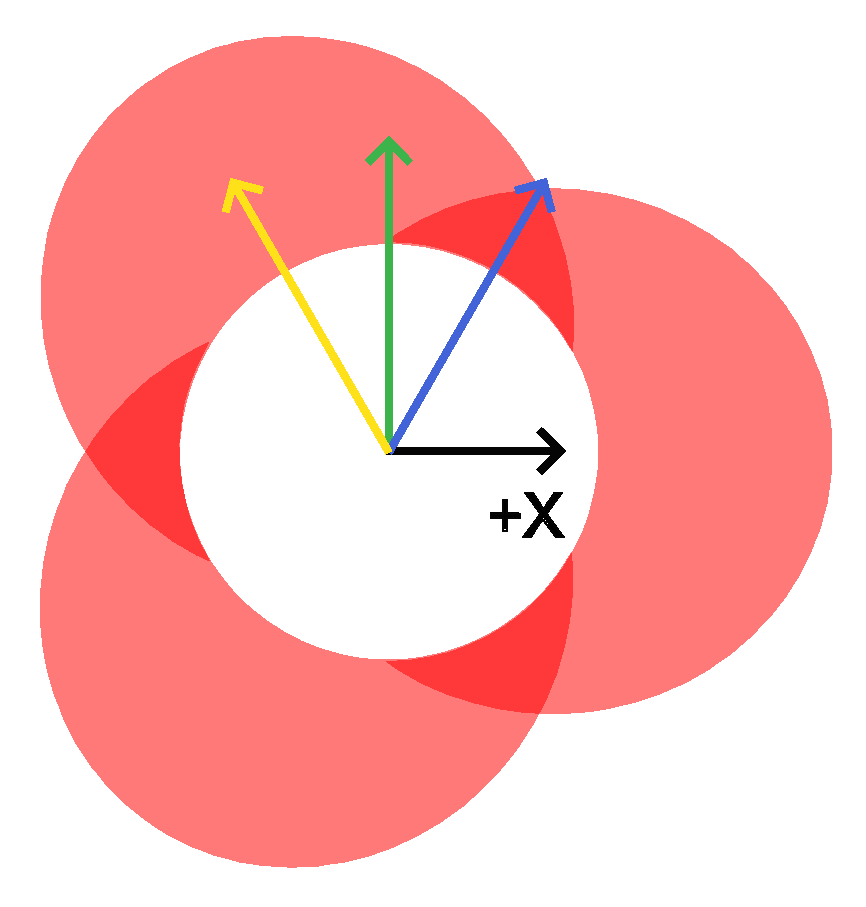
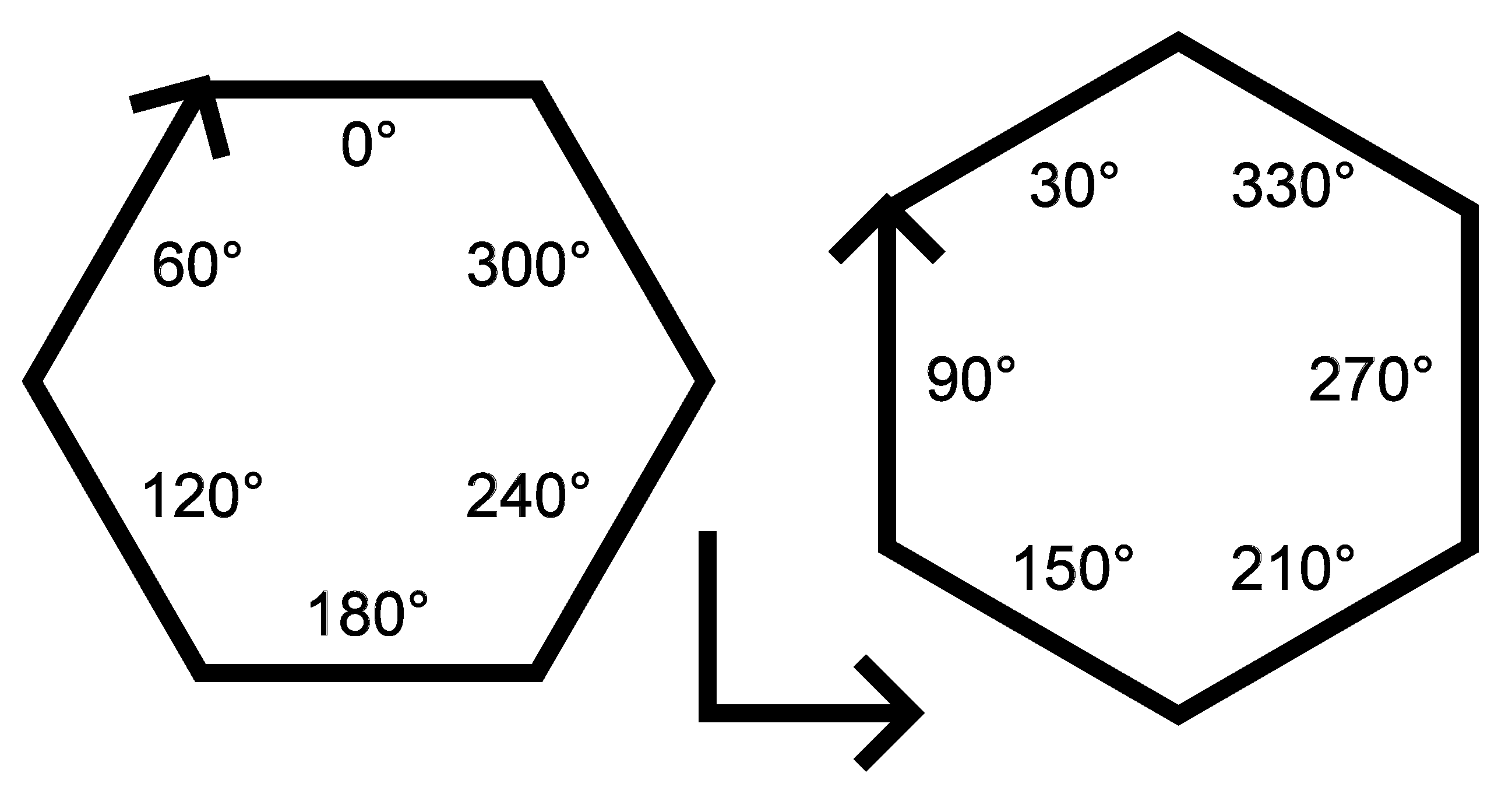
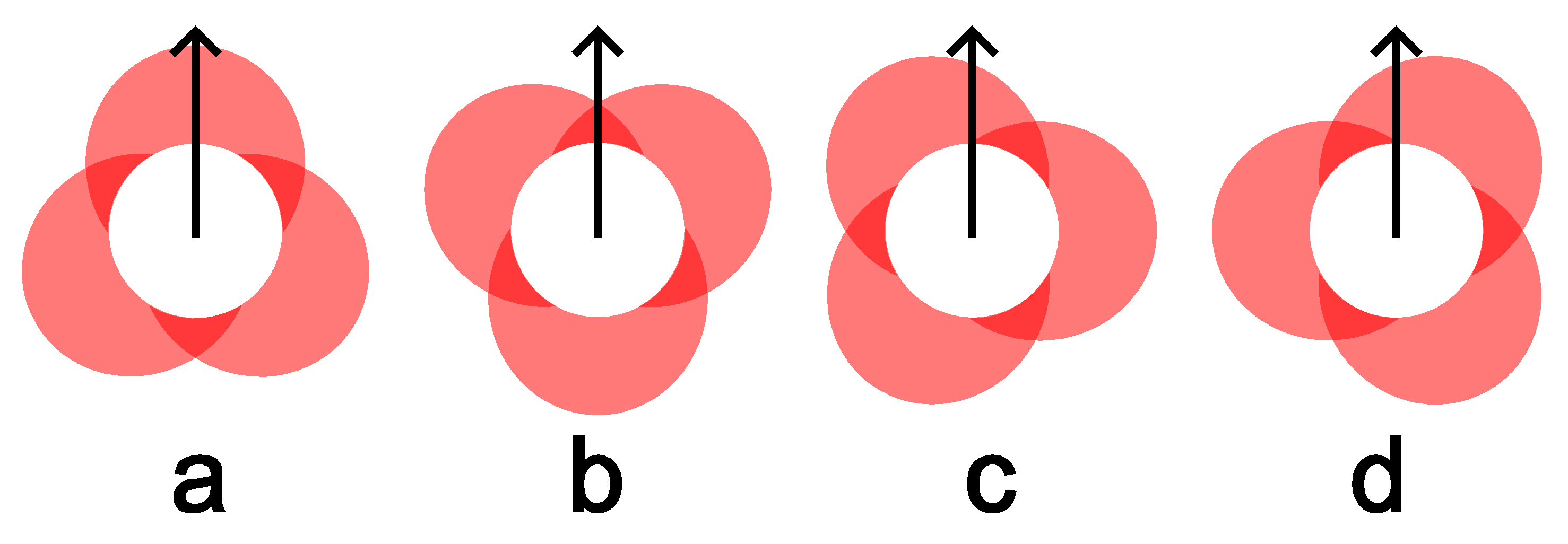
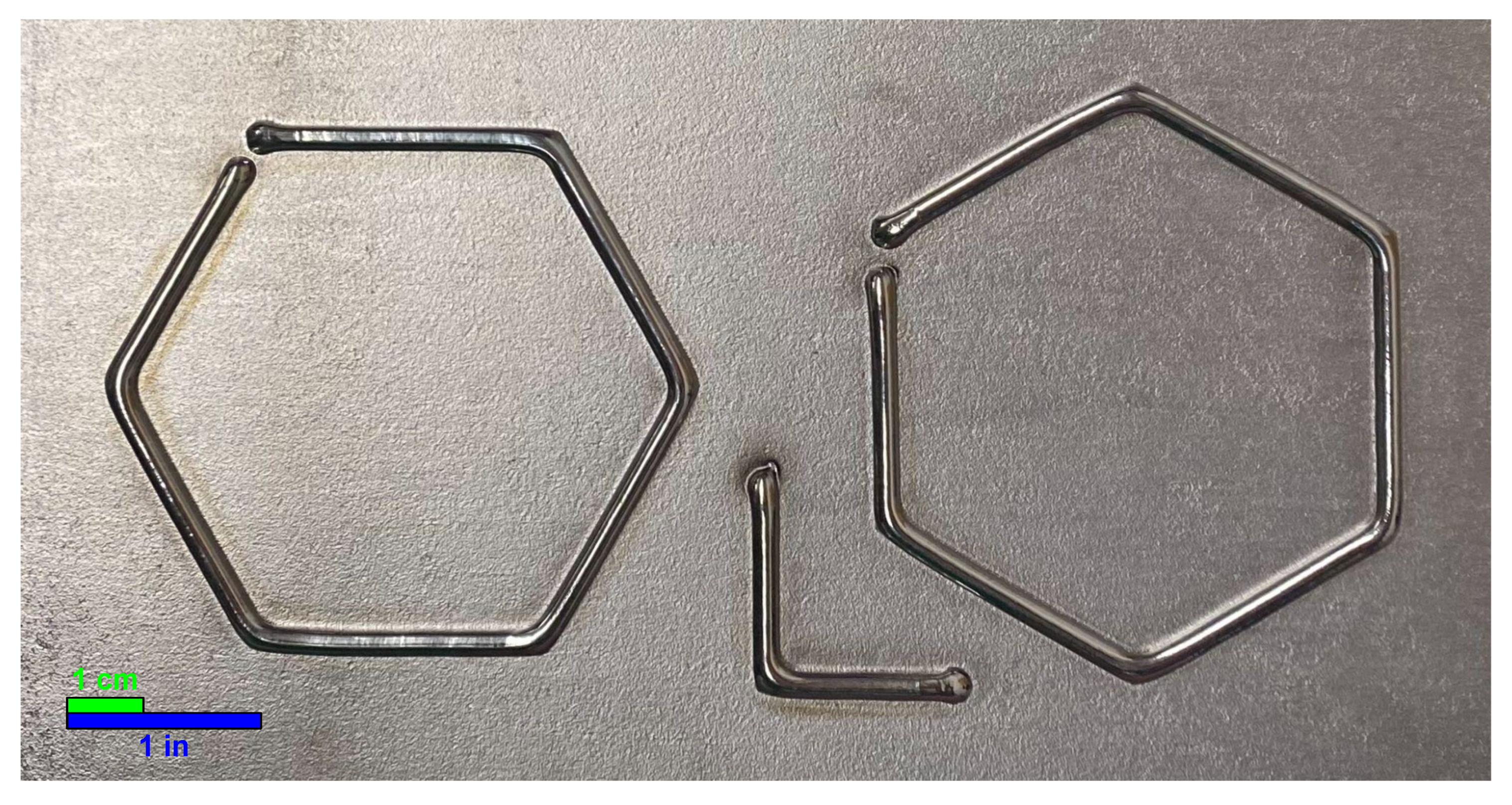
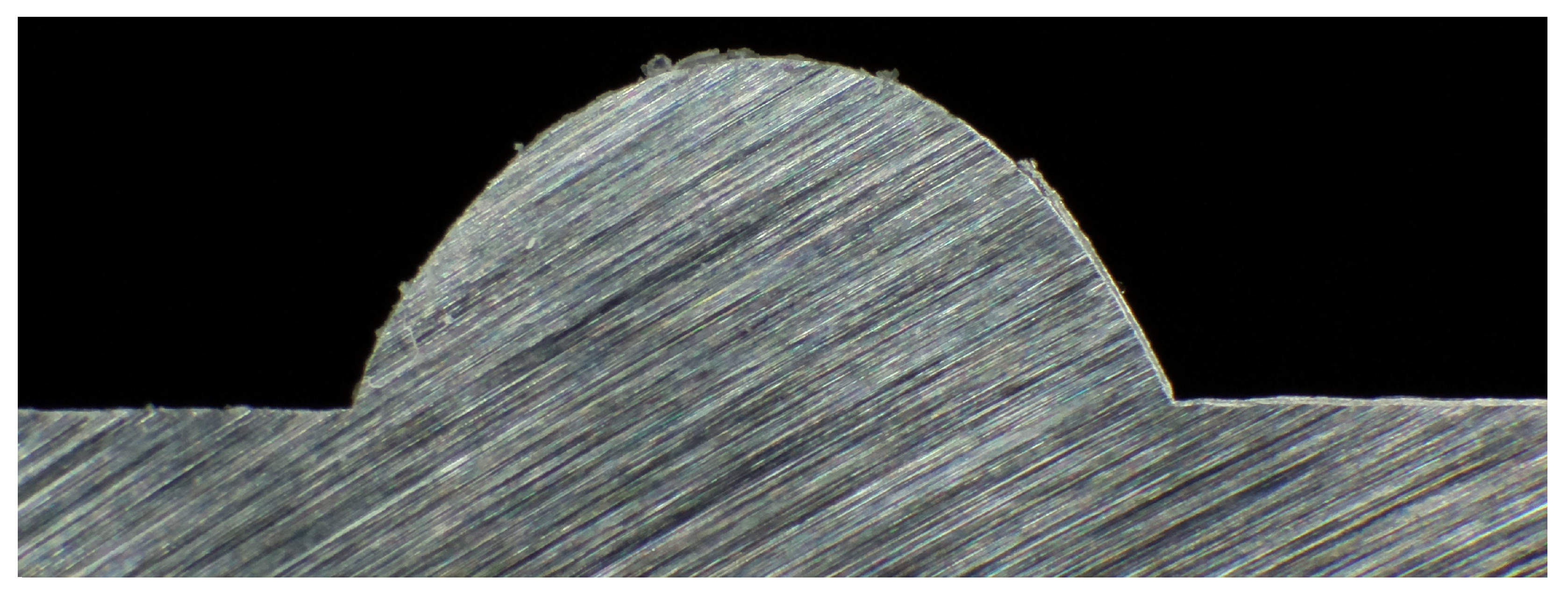
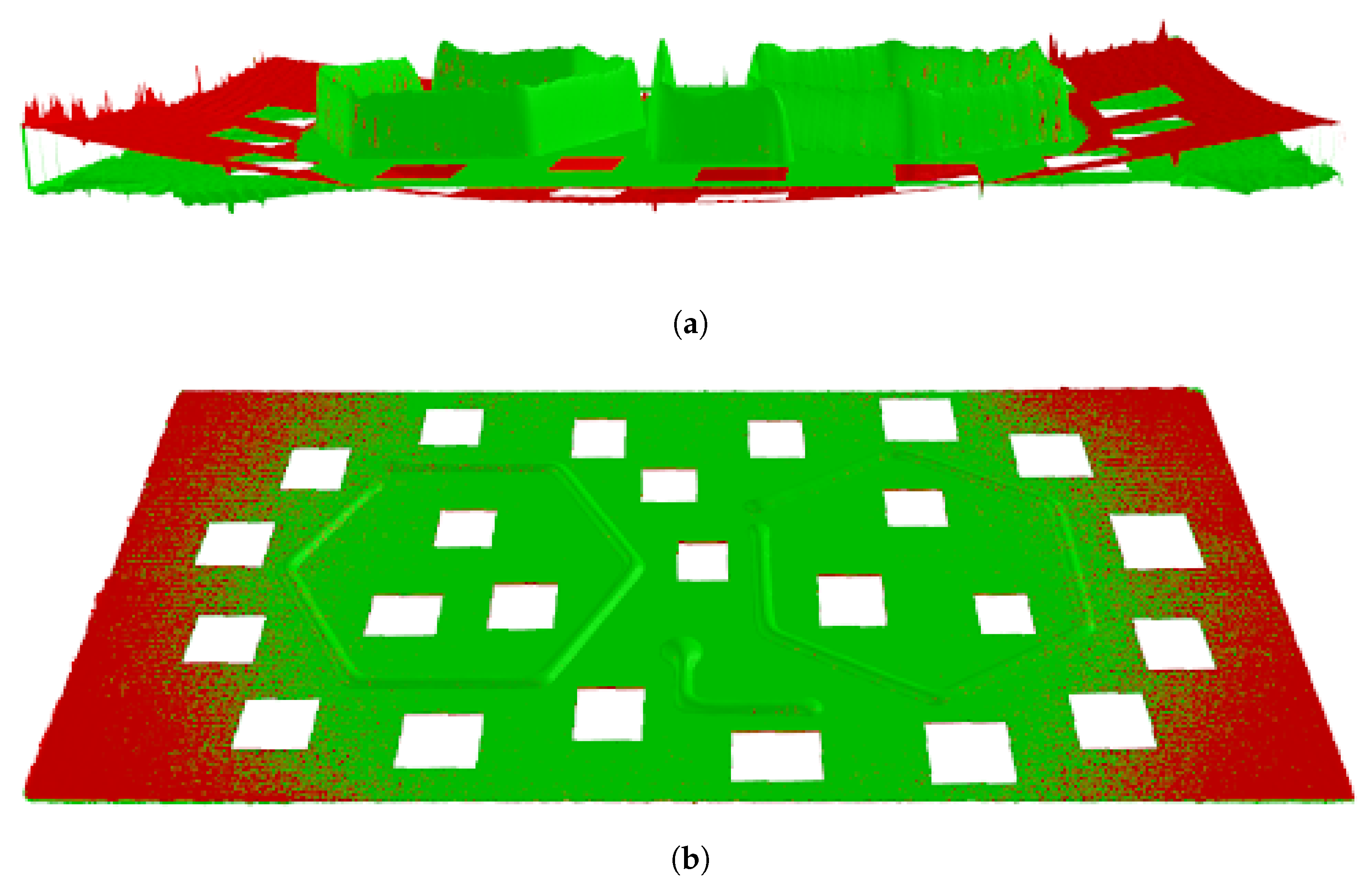
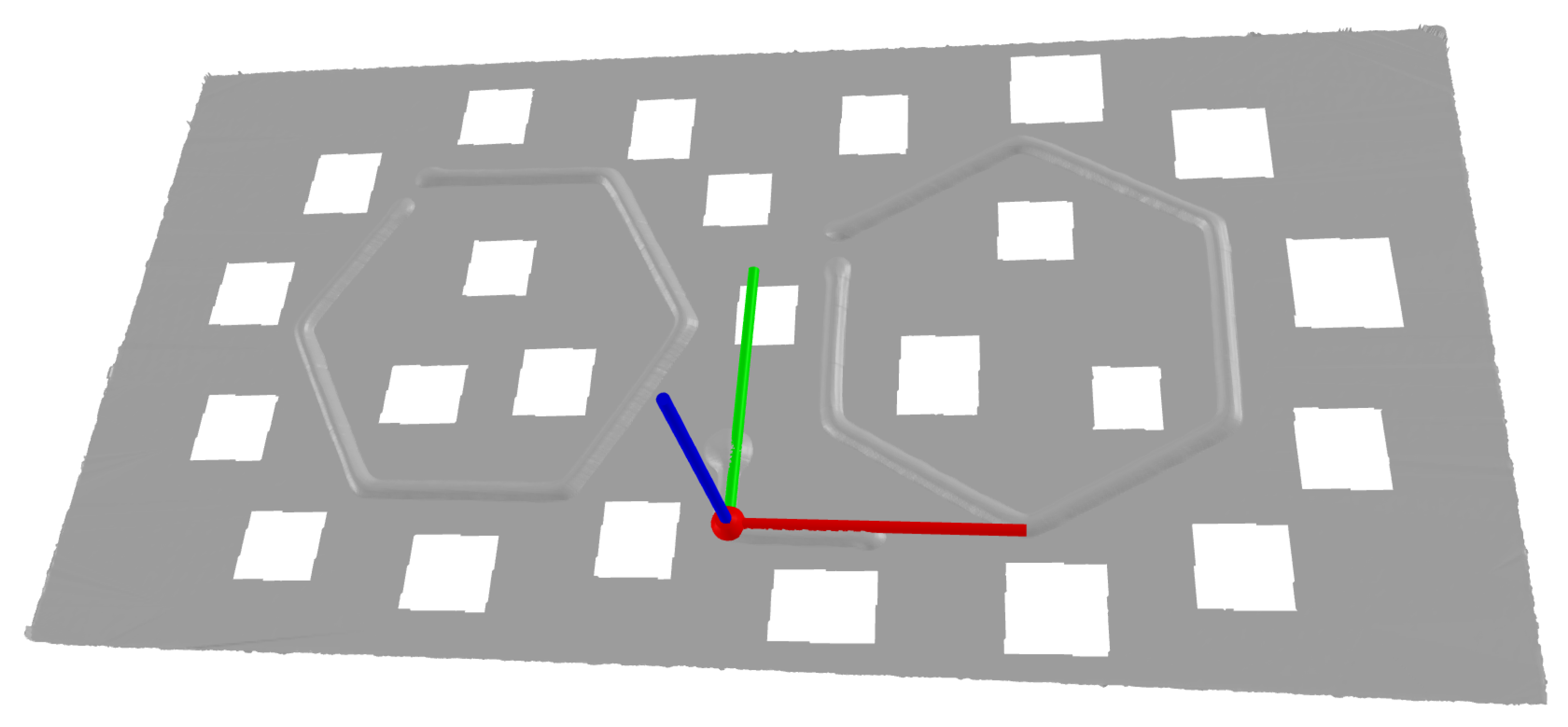

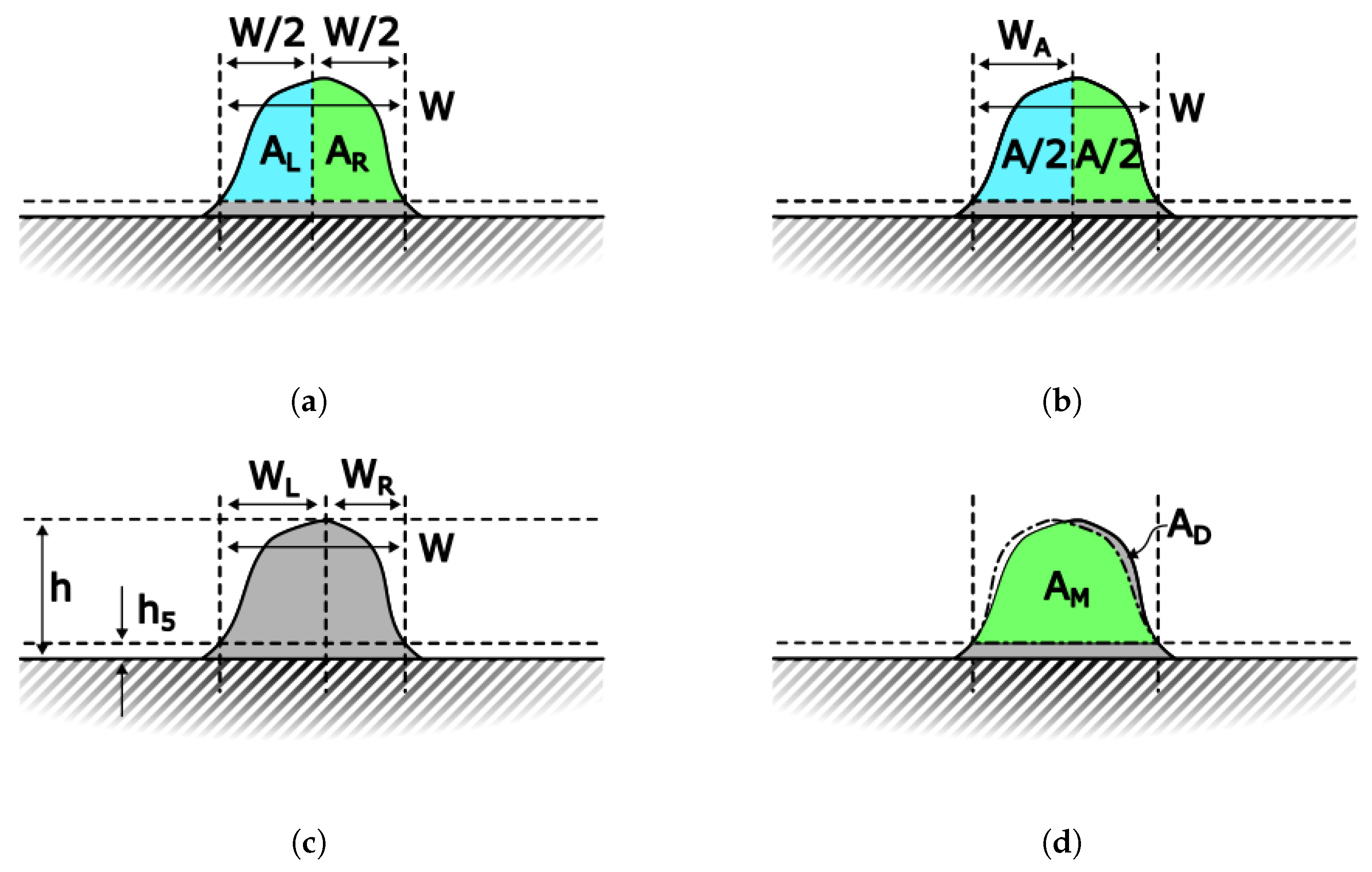
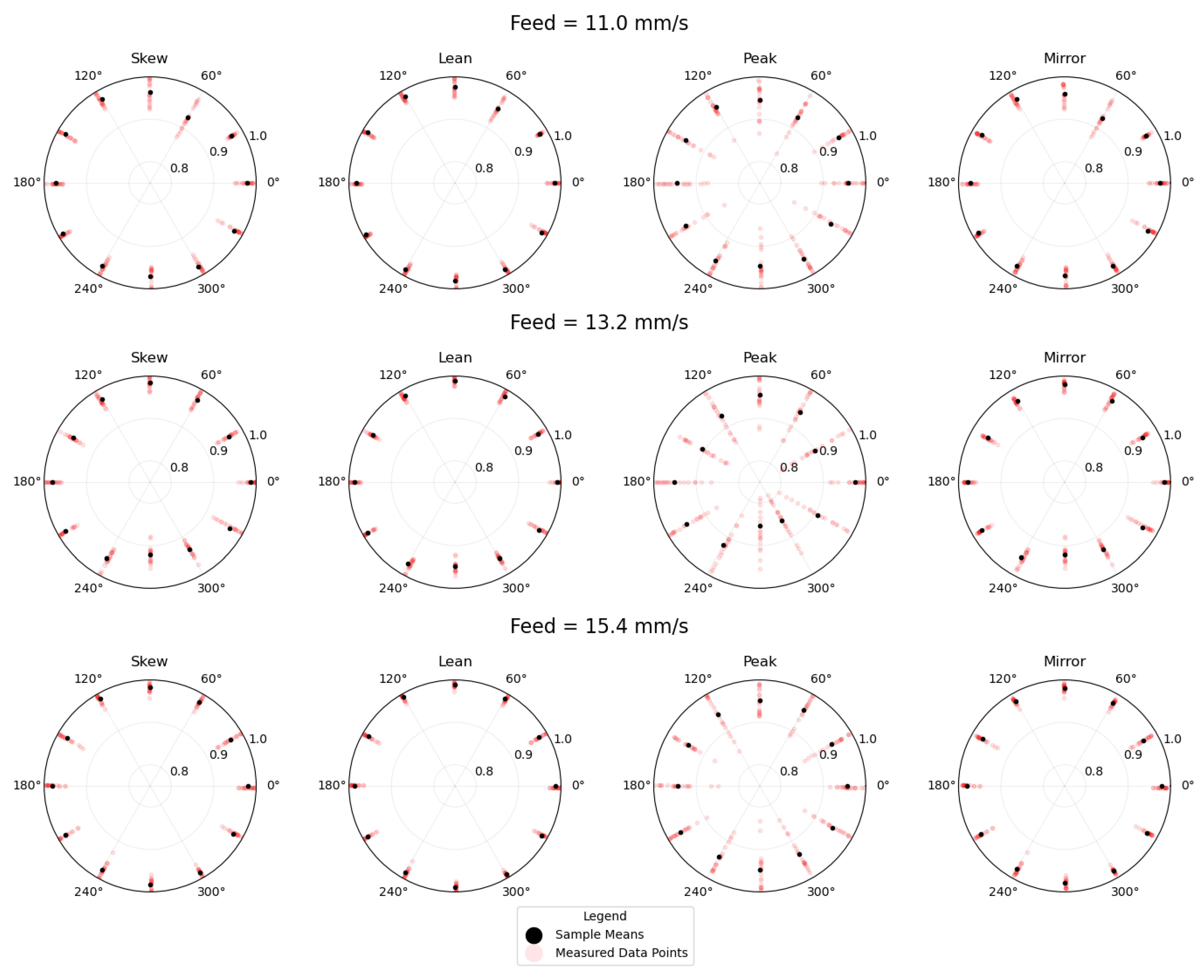

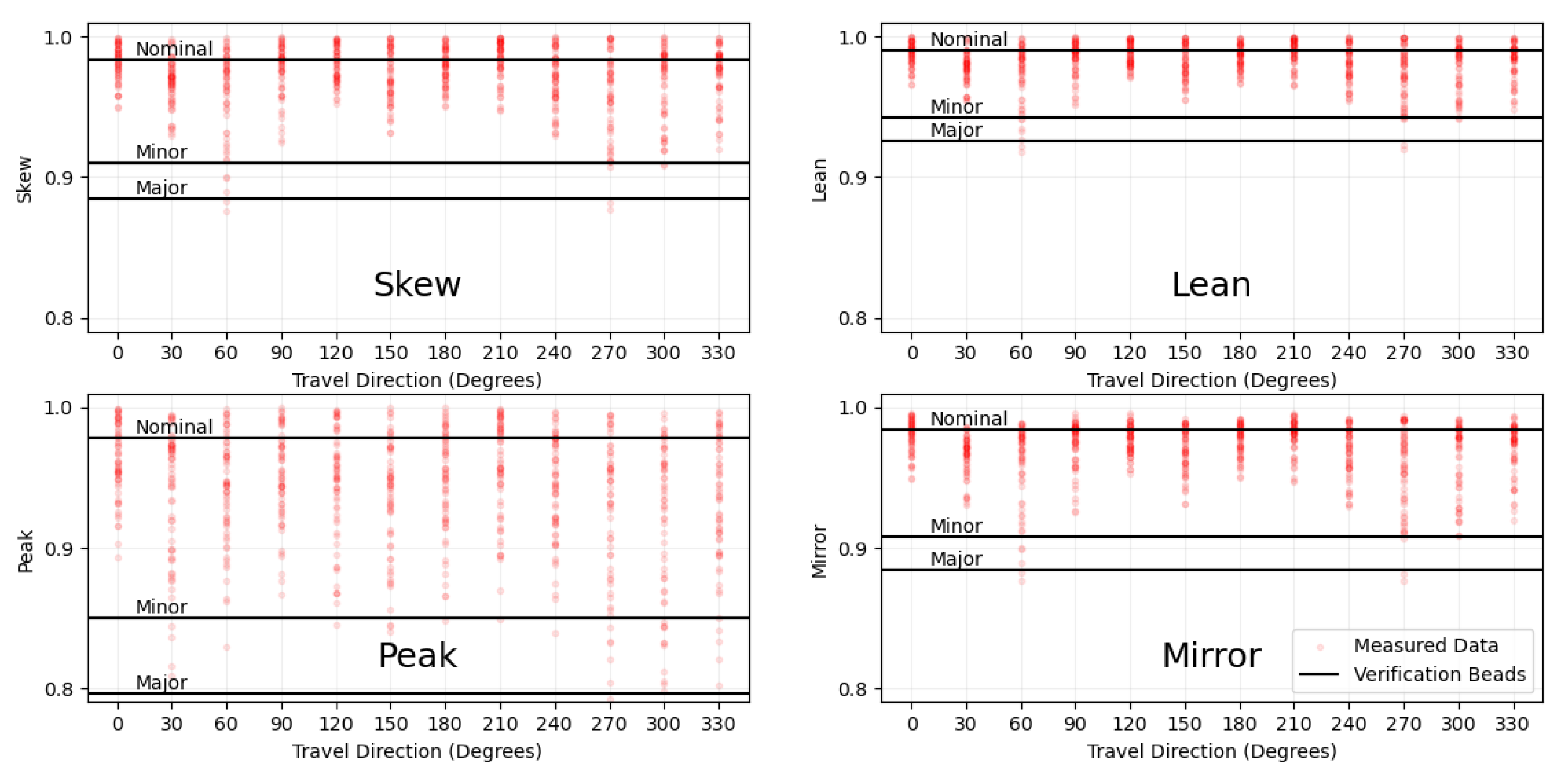
| Treatment Combination | Feed (mm/s) | WFS (mm/s) | WIP (%) | LP (W) |
|---|---|---|---|---|
| 1 | 11.0 | 38.3 | 55.0% | 1400 |
| 2 | 13.2 | 46.0 | 55.0% | 1680 |
| 3 | 15.4 | 53.6 | 55.0% | 1960 |
| Absolute Angle (°) | Relative Angle (°) | Feed (mm/s) | Skew | Lean | Peak | Mirror |
|---|---|---|---|---|---|---|
| 0 | 0 | 11.0 | 0.9775 | 0.9847 | 0.9574 | 0.9751 |
| 30 | 30 | 11.0 | 0.9718 | 0.9804 | 0.9637 | 0.9713 |
| 60 | 60 | 11.0 | 0.9272 | 0.9516 | 0.9291 | 0.9269 |
| 90 | 30 | 11.0 | 0.9635 | 0.9762 | 0.9451 | 0.9596 |
| 120 | 0 | 11.0 | 0.9789 | 0.9863 | 0.9572 | 0.9778 |
| 150 | 30 | 11.0 | 0.9801 | 0.9869 | 0.9521 | 0.9764 |
| 180 | 60 | 11.0 | 0.9732 | 0.9821 | 0.9456 | 0.9726 |
| 210 | 30 | 11.0 | 0.9891 | 0.9929 | 0.9524 | 0.9857 |
| 240 | 0 | 11.0 | 0.9770 | 0.9851 | 0.9615 | 0.9754 |
| 270 | 30 | 11.0 | 0.9699 | 0.9806 | 0.9452 | 0.9687 |
| 300 | 60 | 11.0 | 0.9781 | 0.9860 | 0.9575 | 0.9771 |
| 330 | 30 | 11.0 | 0.9771 | 0.9848 | 0.9417 | 0.9763 |
| 0 | 0 | 13.2 | 0.9875 | 0.9918 | 0.9755 | 0.9861 |
| 30 | 30 | 13.2 | 0.9628 | 0.9754 | 0.8997 | 0.9611 |
| 60 | 60 | 13.2 | 0.9734 | 0.9828 | 0.9411 | 0.9719 |
| 90 | 30 | 13.2 | 0.9840 | 0.9898 | 0.9559 | 0.9799 |
| 120 | 0 | 13.2 | 0.9754 | 0.9849 | 0.9305 | 0.9723 |
| 150 | 30 | 13.2 | 0.9605 | 0.9744 | 0.9060 | 0.9591 |
| 180 | 60 | 13.2 | 0.9814 | 0.9876 | 0.9511 | 0.9785 |
| 210 | 30 | 13.2 | 0.9813 | 0.9874 | 0.9490 | 0.9762 |
| 240 | 0 | 13.2 | 0.9561 | 0.9717 | 0.9220 | 0.9544 |
| 270 | 30 | 13.2 | 0.9202 | 0.9487 | 0.8532 | 0.9201 |
| 300 | 60 | 13.2 | 0.9336 | 0.9581 | 0.8543 | 0.9330 |
| 330 | 30 | 13.2 | 0.9669 | 0.9784 | 0.9072 | 0.9622 |
| 0 | 0 | 15.4 | 0.9799 | 0.9868 | 0.9559 | 0.9786 |
| 30 | 30 | 15.4 | 0.9674 | 0.9787 | 0.9458 | 0.9645 |
| 60 | 60 | 15.4 | 0.9795 | 0.9867 | 0.9558 | 0.9756 |
| 90 | 30 | 15.4 | 0.9822 | 0.9885 | 0.9512 | 0.9814 |
| 120 | 0 | 15.4 | 0.9873 | 0.9919 | 0.9462 | 0.9819 |
| 150 | 30 | 15.4 | 0.9770 | 0.9850 | 0.9453 | 0.9730 |
| 180 | 60 | 15.4 | 0.9815 | 0.9876 | 0.9441 | 0.9797 |
| 210 | 30 | 15.4 | 0.9806 | 0.9871 | 0.9665 | 0.9782 |
| 240 | 0 | 15.4 | 0.9772 | 0.9854 | 0.9431 | 0.9751 |
| 270 | 30 | 15.4 | 0.9819 | 0.9887 | 0.9471 | 0.9795 |
| 300 | 60 | 15.4 | 0.9856 | 0.9910 | 0.9346 | 0.9809 |
| 330 | 30 | 15.4 | 0.9762 | 0.9844 | 0.9467 | 0.9742 |
| Factors | Response | p-Value |
|---|---|---|
| Absolute and Feed | Skew | 0.5414 |
| Absolute and Feed | Lean | 0.5114 |
| Absolute and Feed | Peak | 0.8331 |
| Absolute and Feed | Mirror | 0.5702 |
| Relative and Feed | Skew | 0.2641 |
| Relative and Feed | Lean | 0.2887 |
| Relative and Feed | Peak | 0.7272 |
| Relative and Feed | Mirror | 0.3085 |
| Bead | Skew | Lean | Peak | Mirror |
|---|---|---|---|---|
| Nominal | 0.9840 | 0.9902 | 0.9781 | 0.9842 |
| Minor | 0.9106 | 0.9428 | 0.8503 | 0.9082 |
| Major | 0.8851 | 0.9260 | 0.7958 | 0.8848 |
Disclaimer/Publisher’s Note: The statements, opinions and data contained in all publications are solely those of the individual author(s) and contributor(s) and not of MDPI and/or the editor(s). MDPI and/or the editor(s) disclaim responsibility for any injury to people or property resulting from any ideas, methods, instructions or products referred to in the content. |
© 2024 by the authors. Licensee MDPI, Basel, Switzerland. This article is an open access article distributed under the terms and conditions of the Creative Commons Attribution (CC BY) license (https://creativecommons.org/licenses/by/4.0/).
Share and Cite
Mathenia, R.; McLain, B.; Sparks, T.; Liou, F. A Study of Directionality Effects in Three-Beam Coaxial Titanium Wire-Based Laser Metal Deposition. Materials 2024, 17, 3201. https://doi.org/10.3390/ma17133201
Mathenia R, McLain B, Sparks T, Liou F. A Study of Directionality Effects in Three-Beam Coaxial Titanium Wire-Based Laser Metal Deposition. Materials. 2024; 17(13):3201. https://doi.org/10.3390/ma17133201
Chicago/Turabian StyleMathenia, Remy, Braden McLain, Todd Sparks, and Frank Liou. 2024. "A Study of Directionality Effects in Three-Beam Coaxial Titanium Wire-Based Laser Metal Deposition" Materials 17, no. 13: 3201. https://doi.org/10.3390/ma17133201







